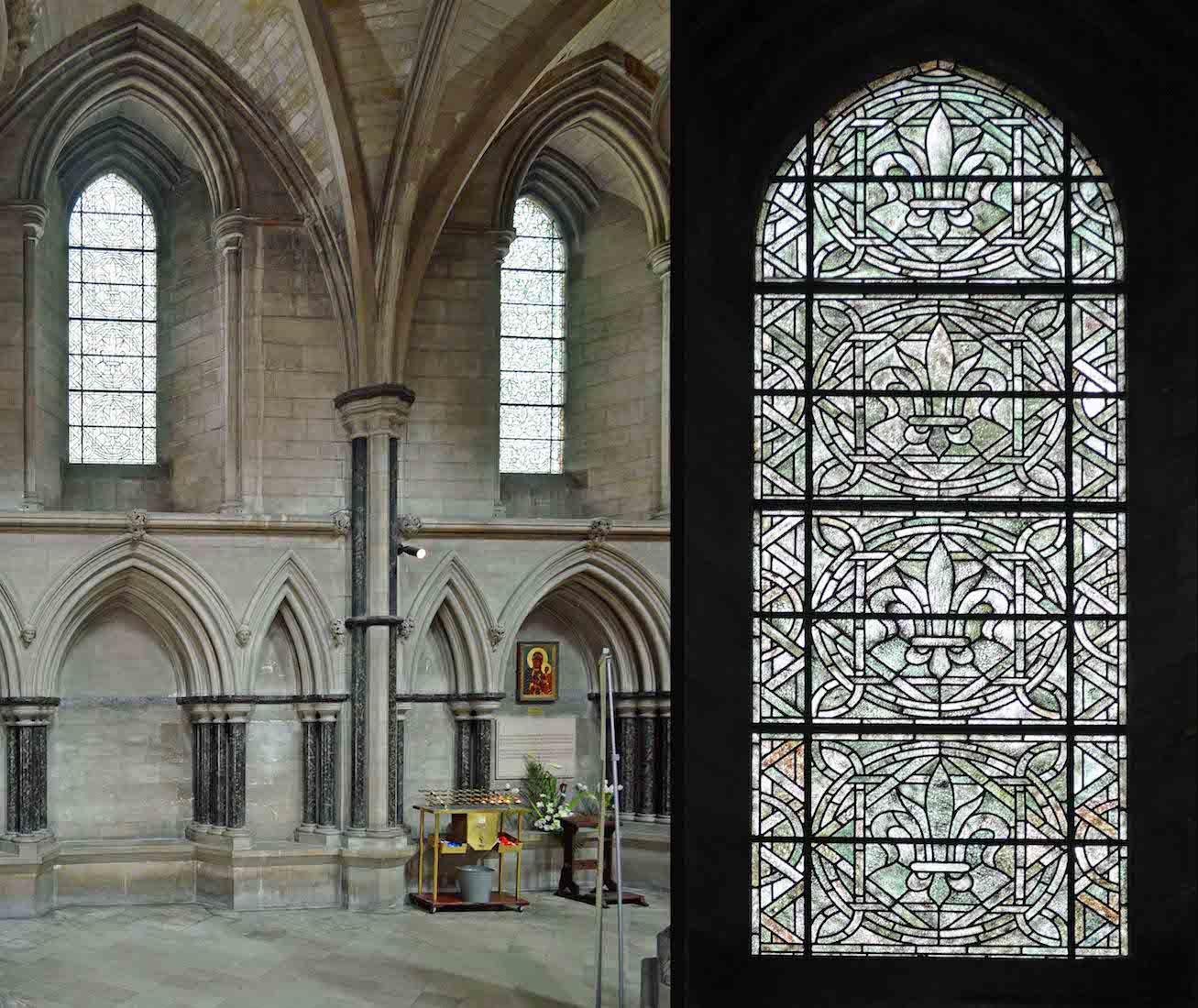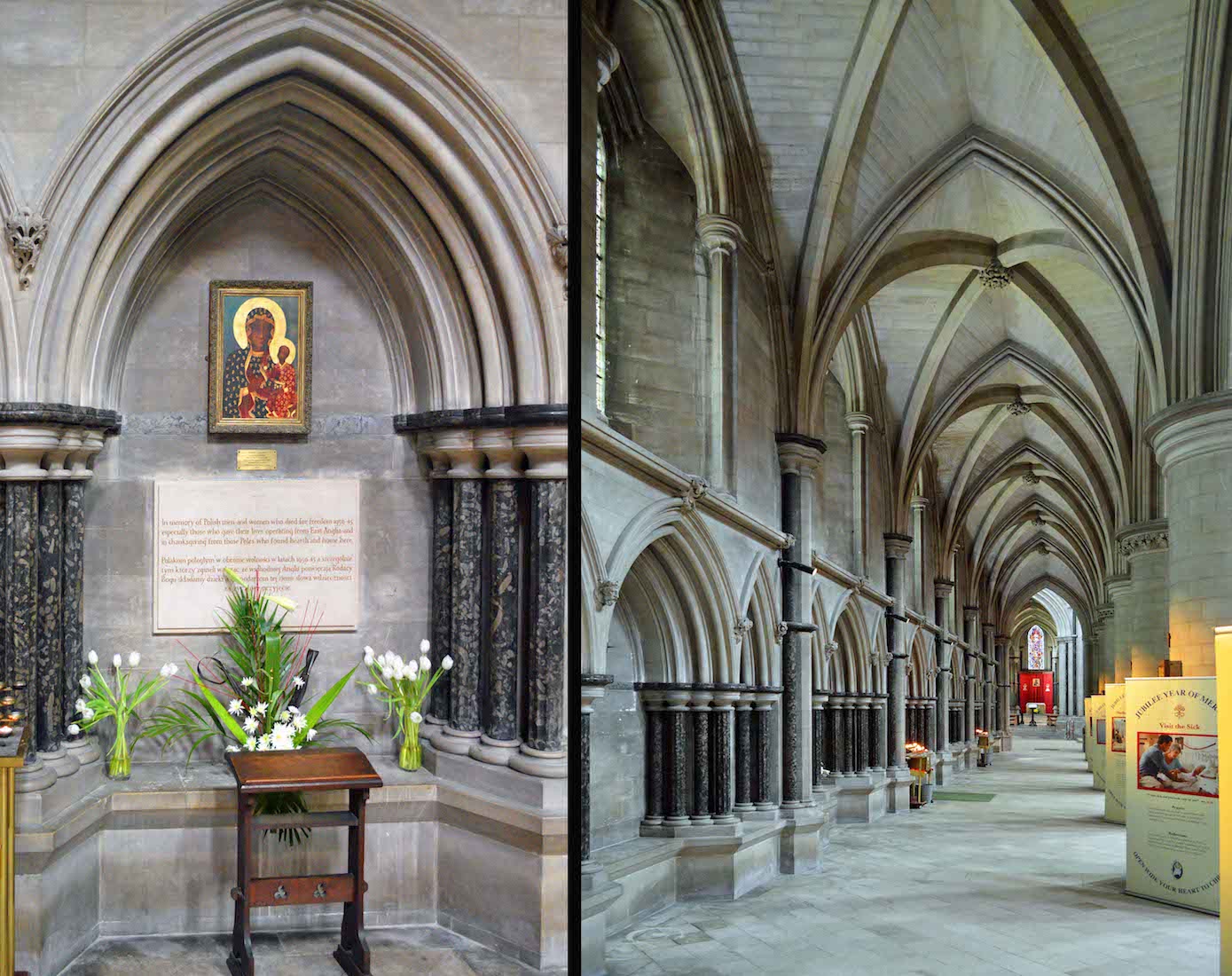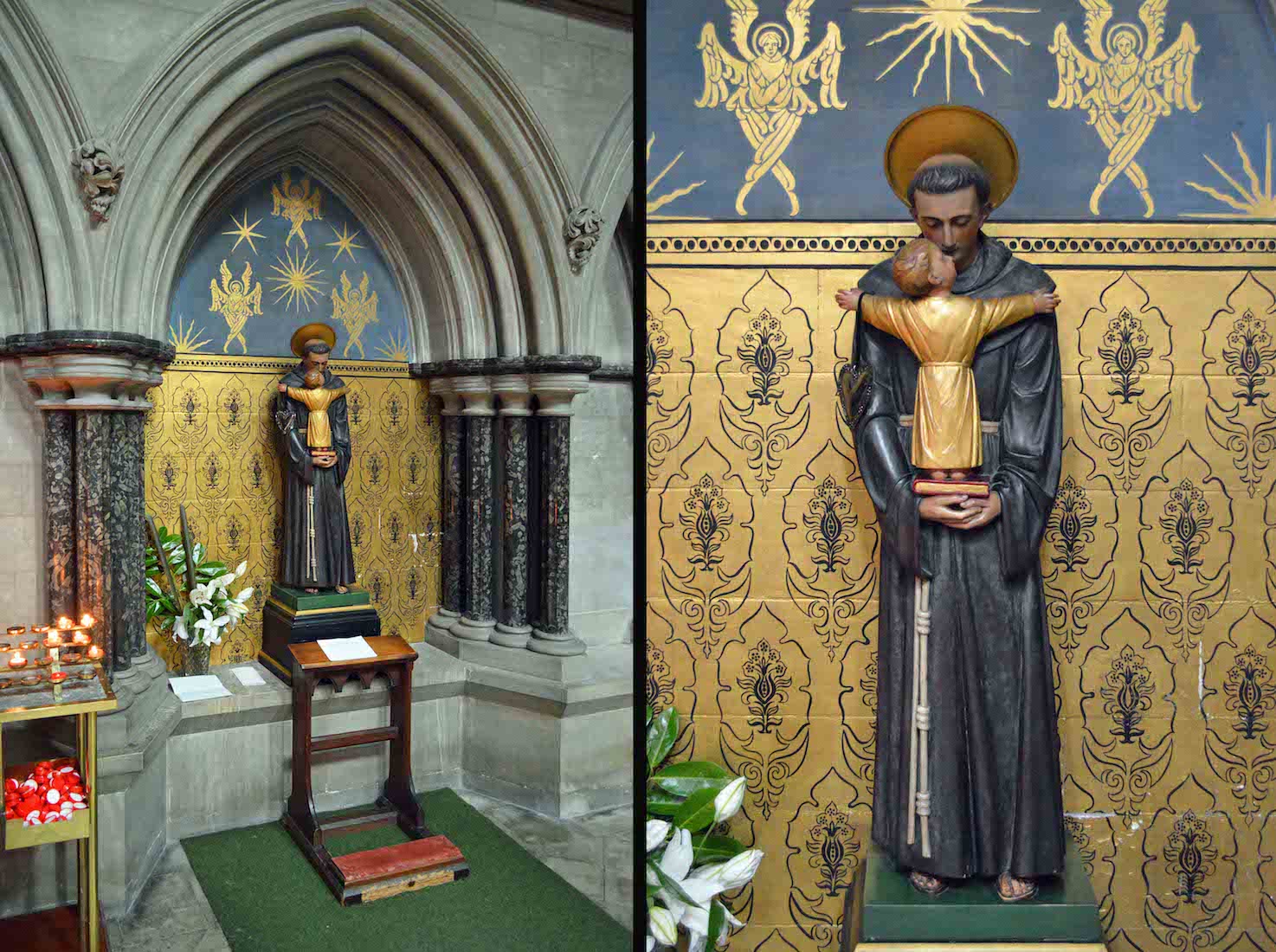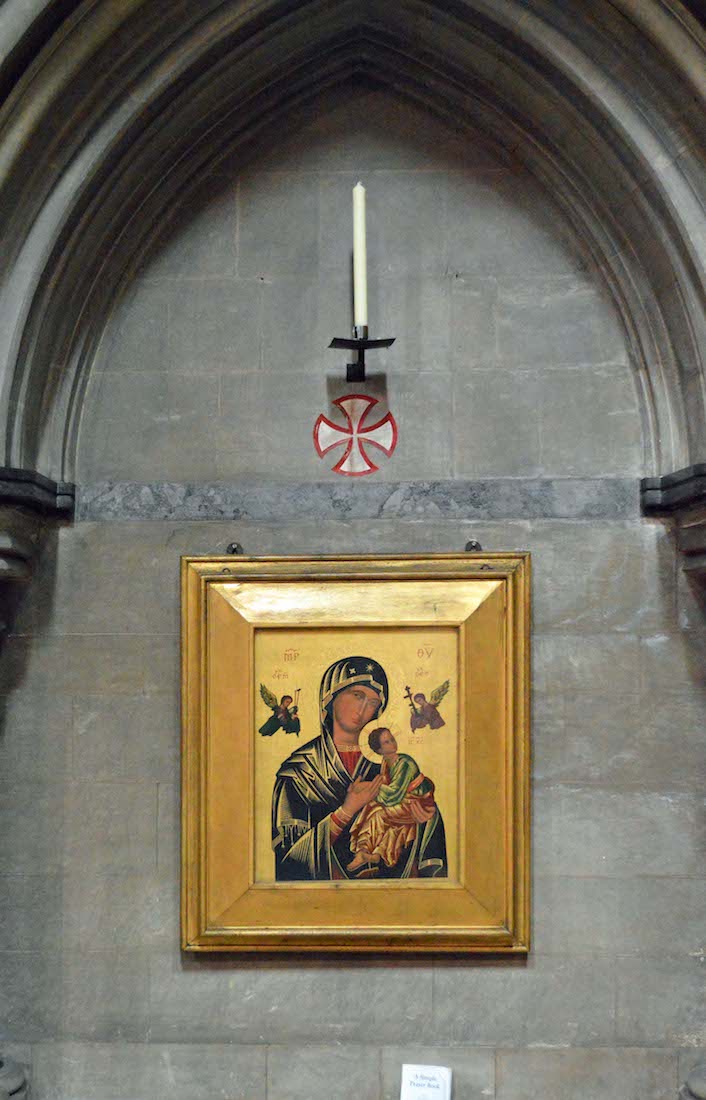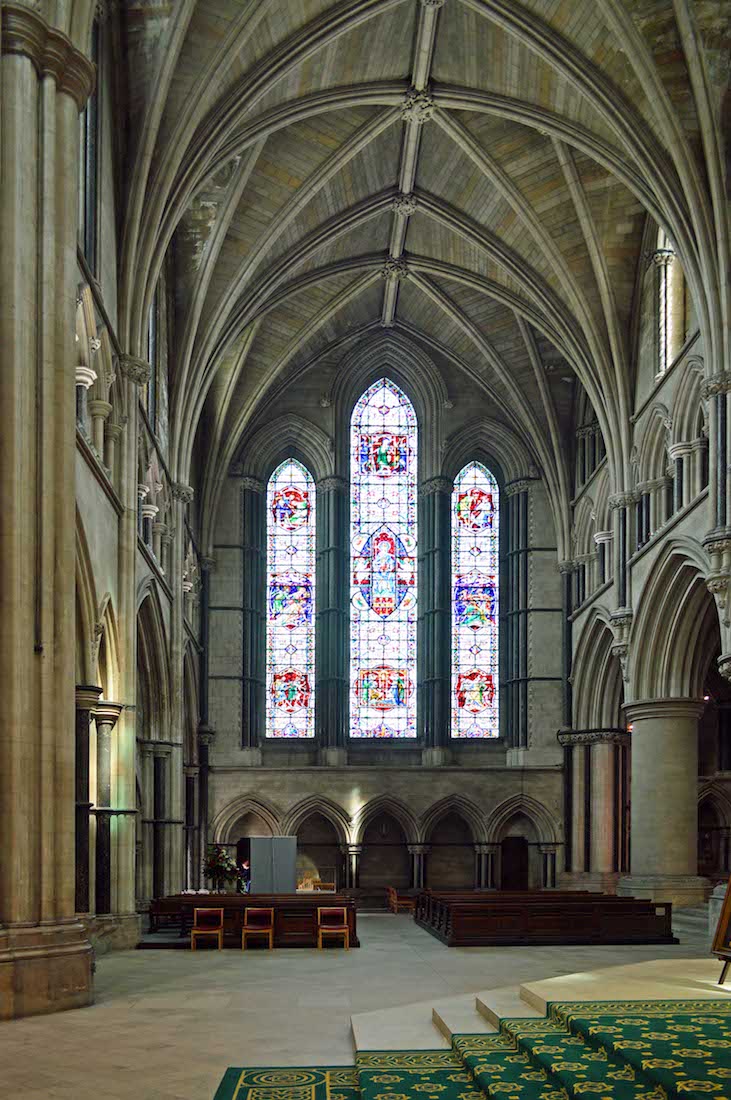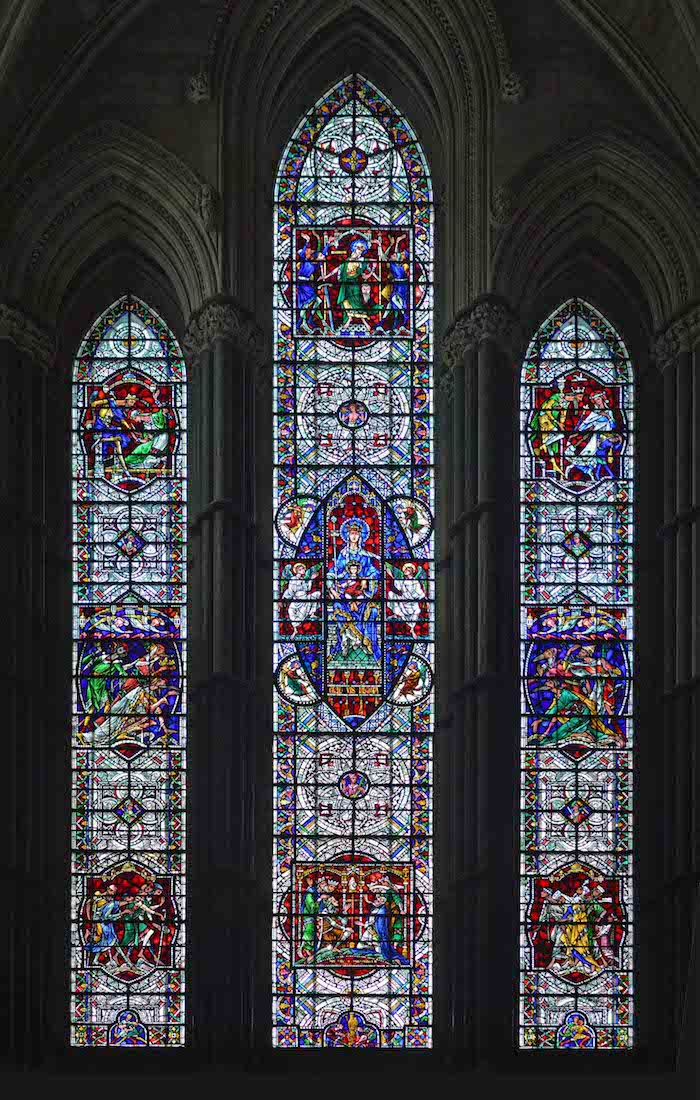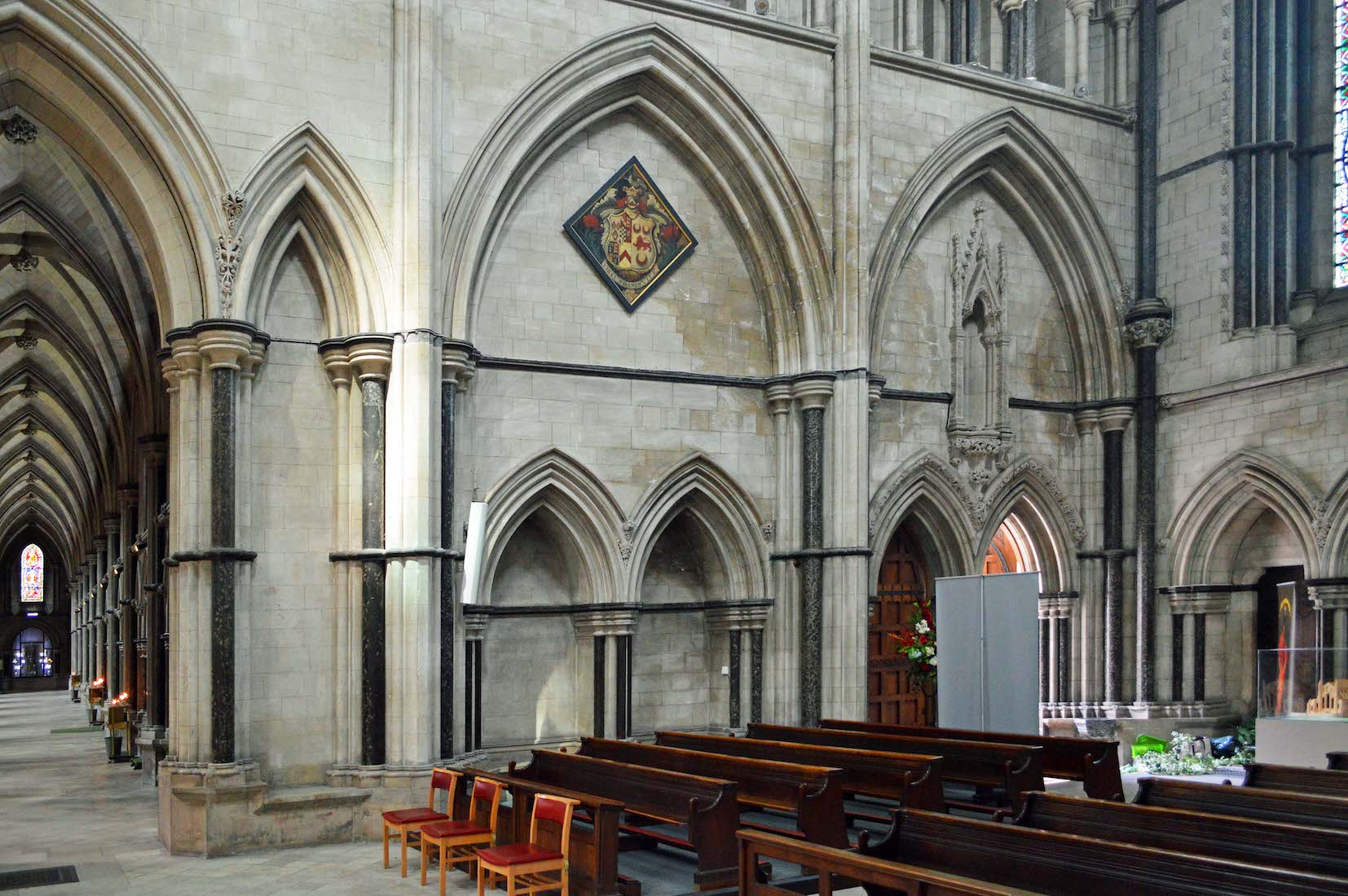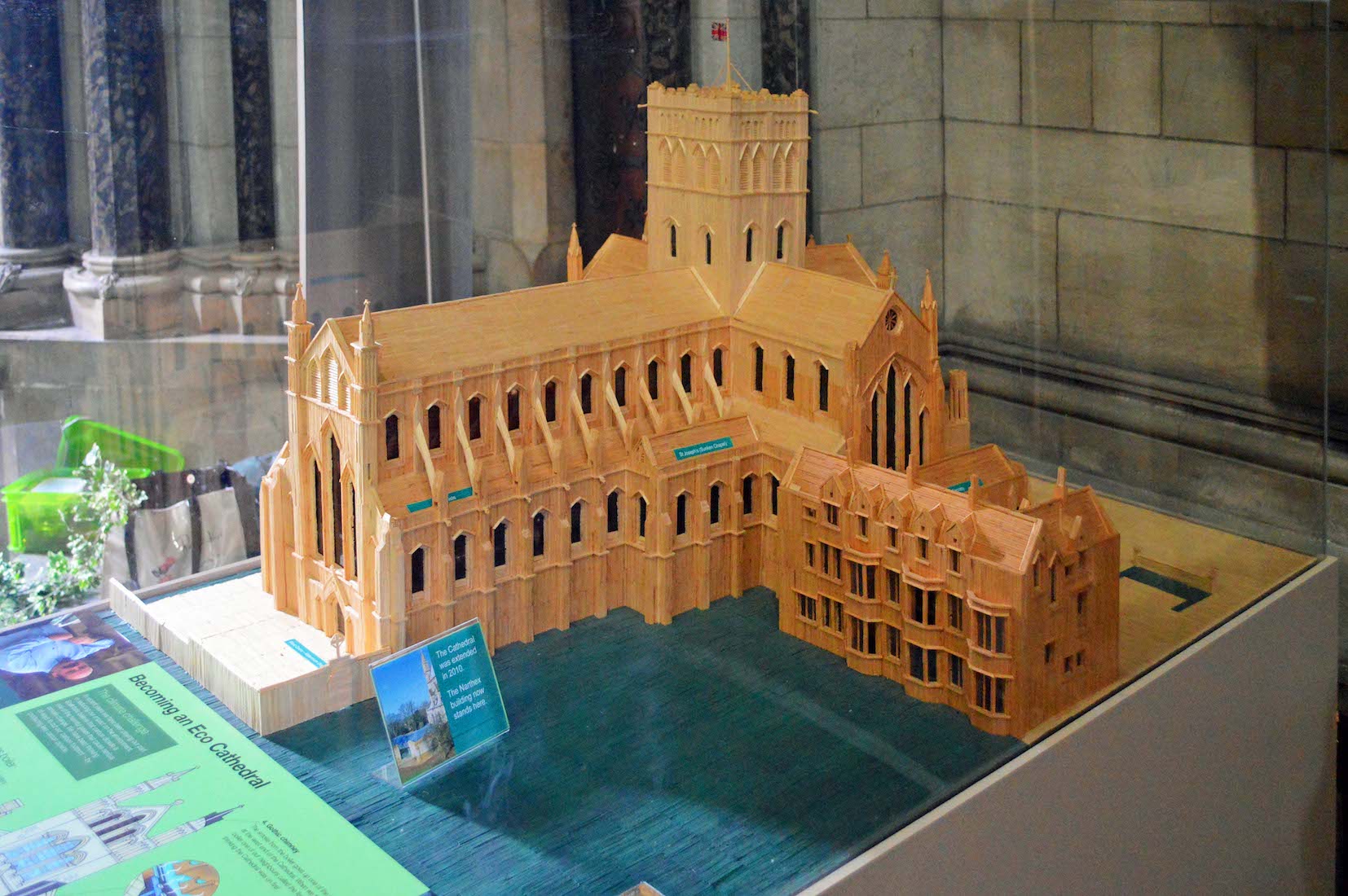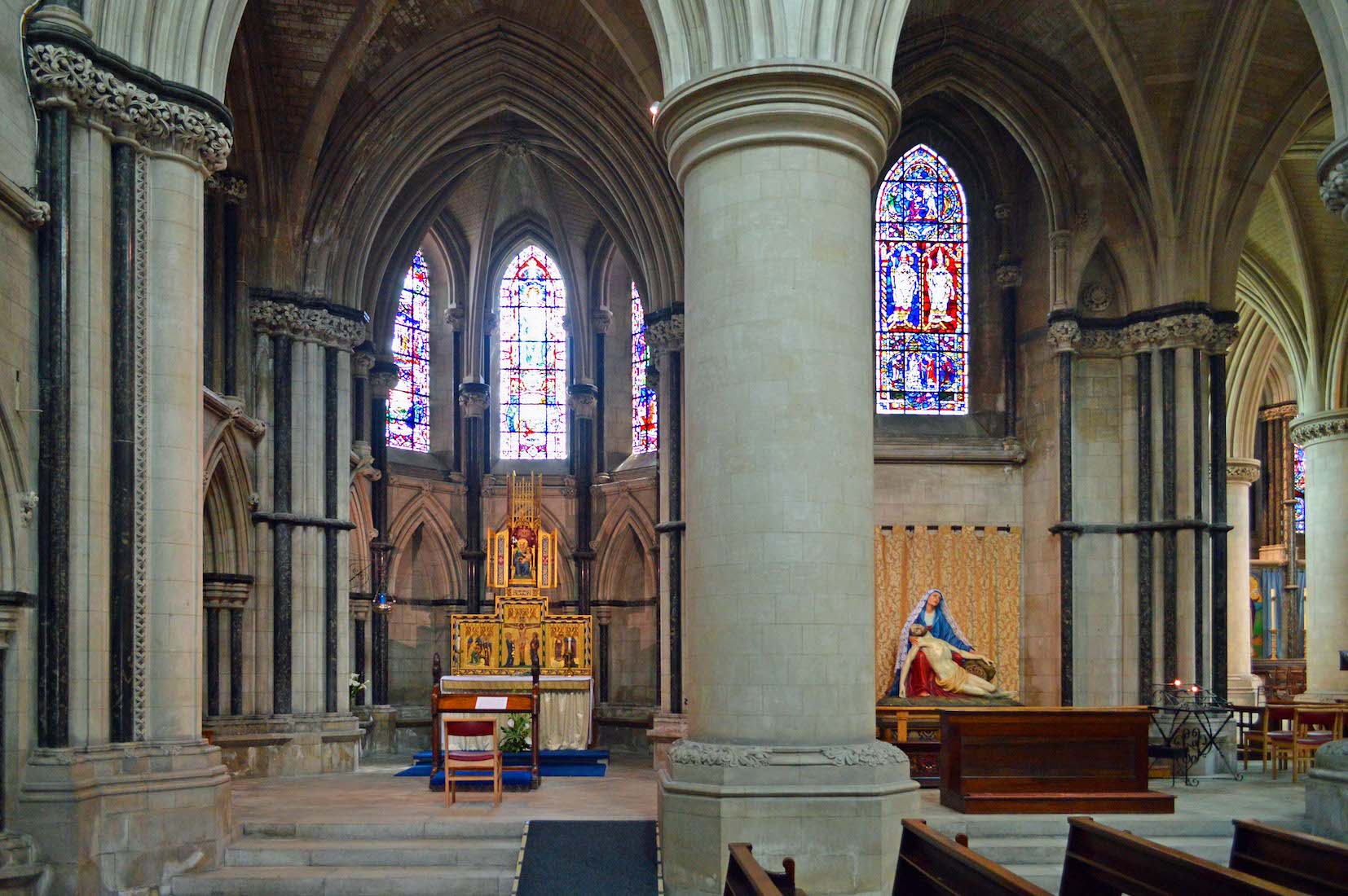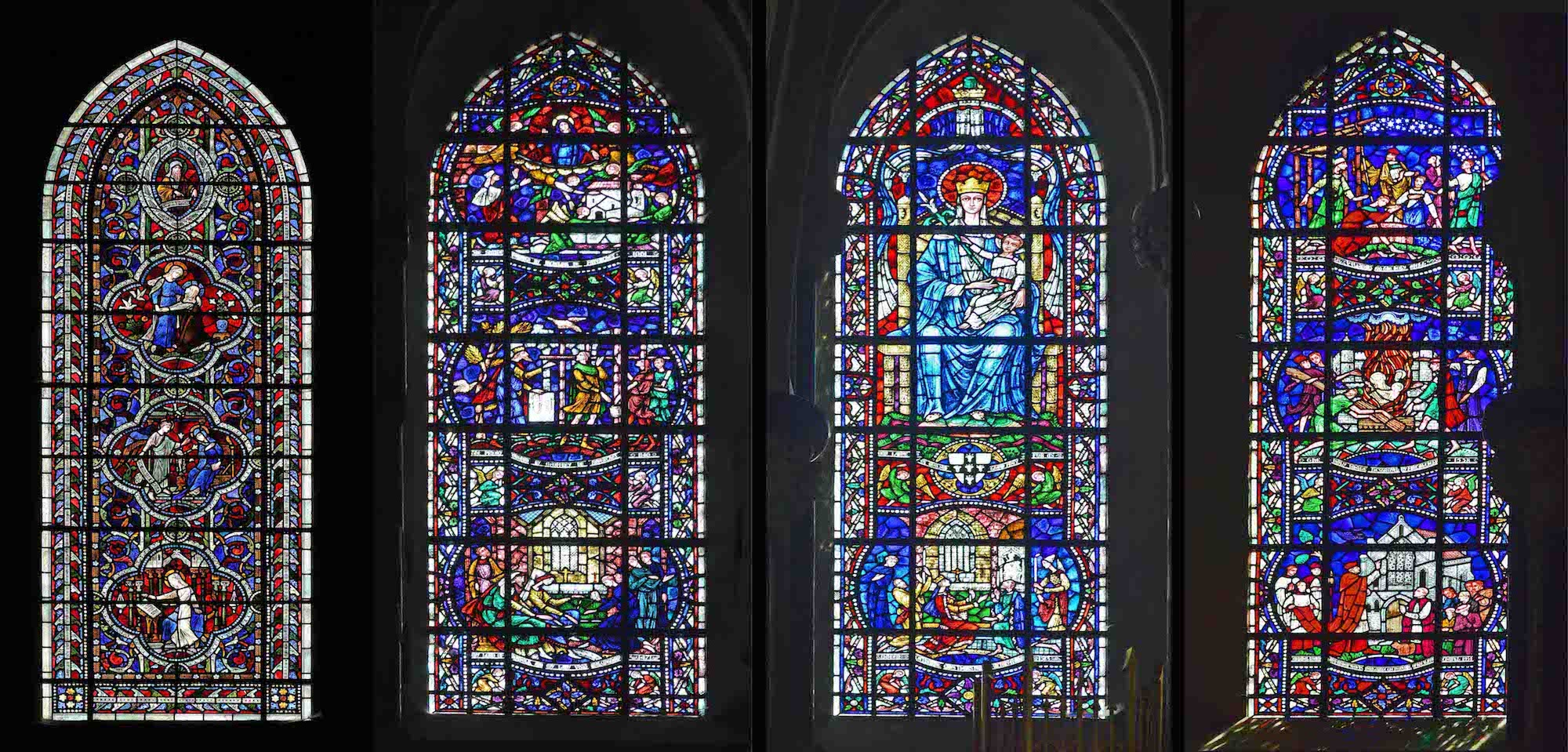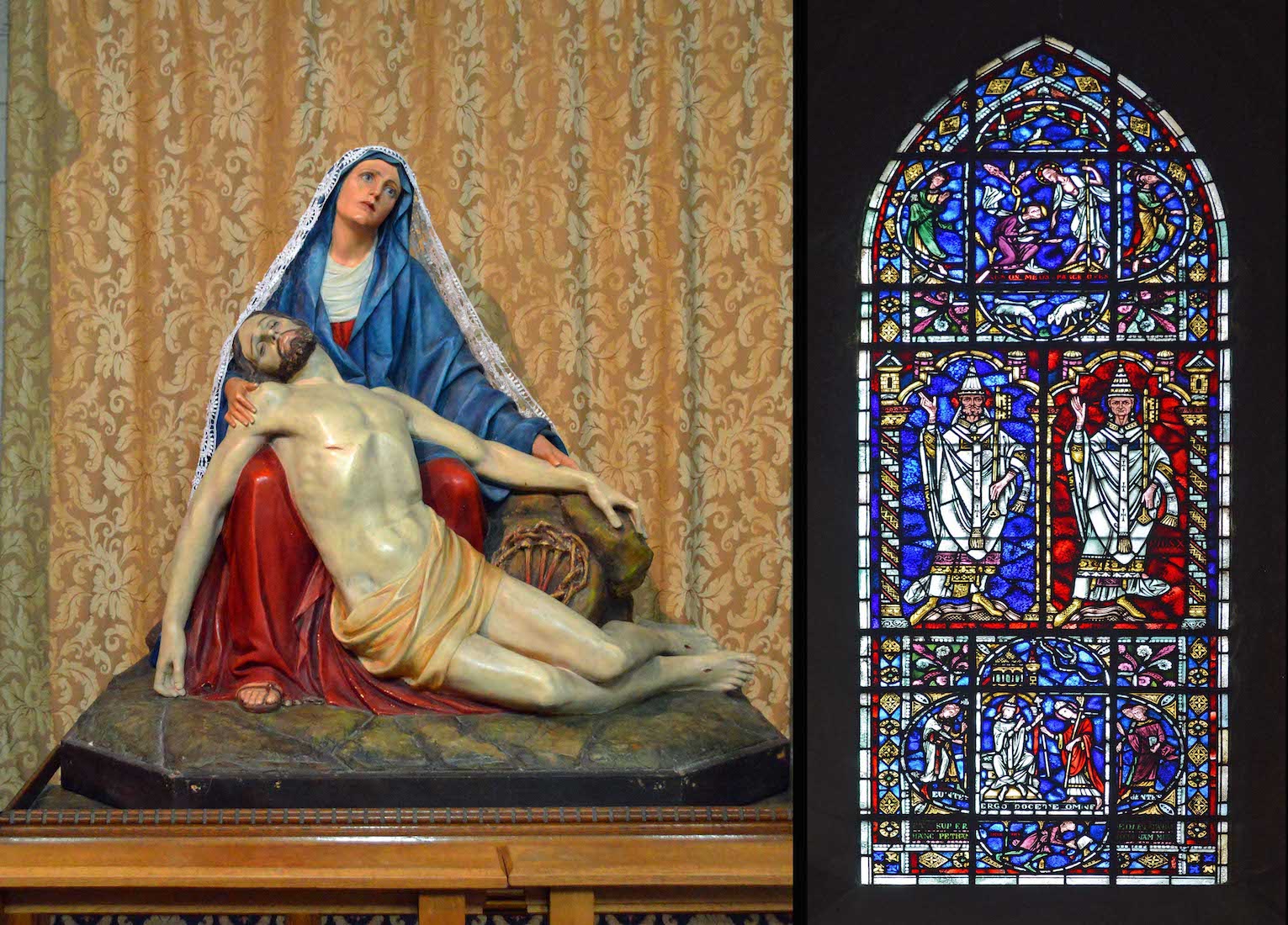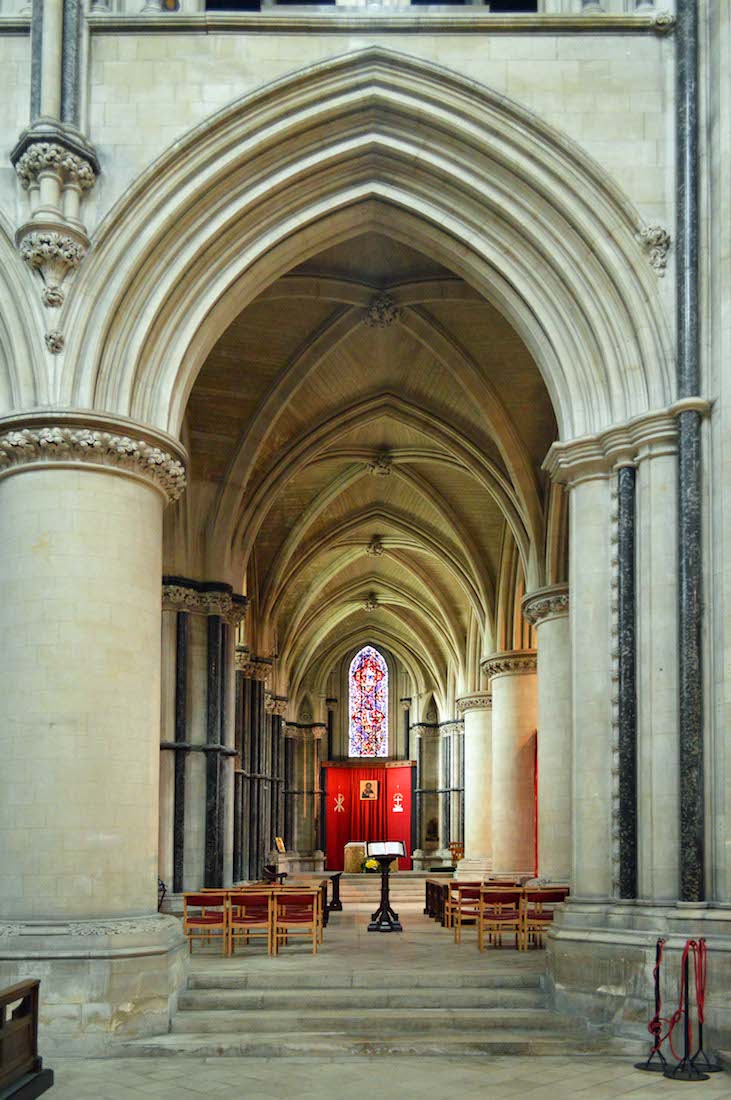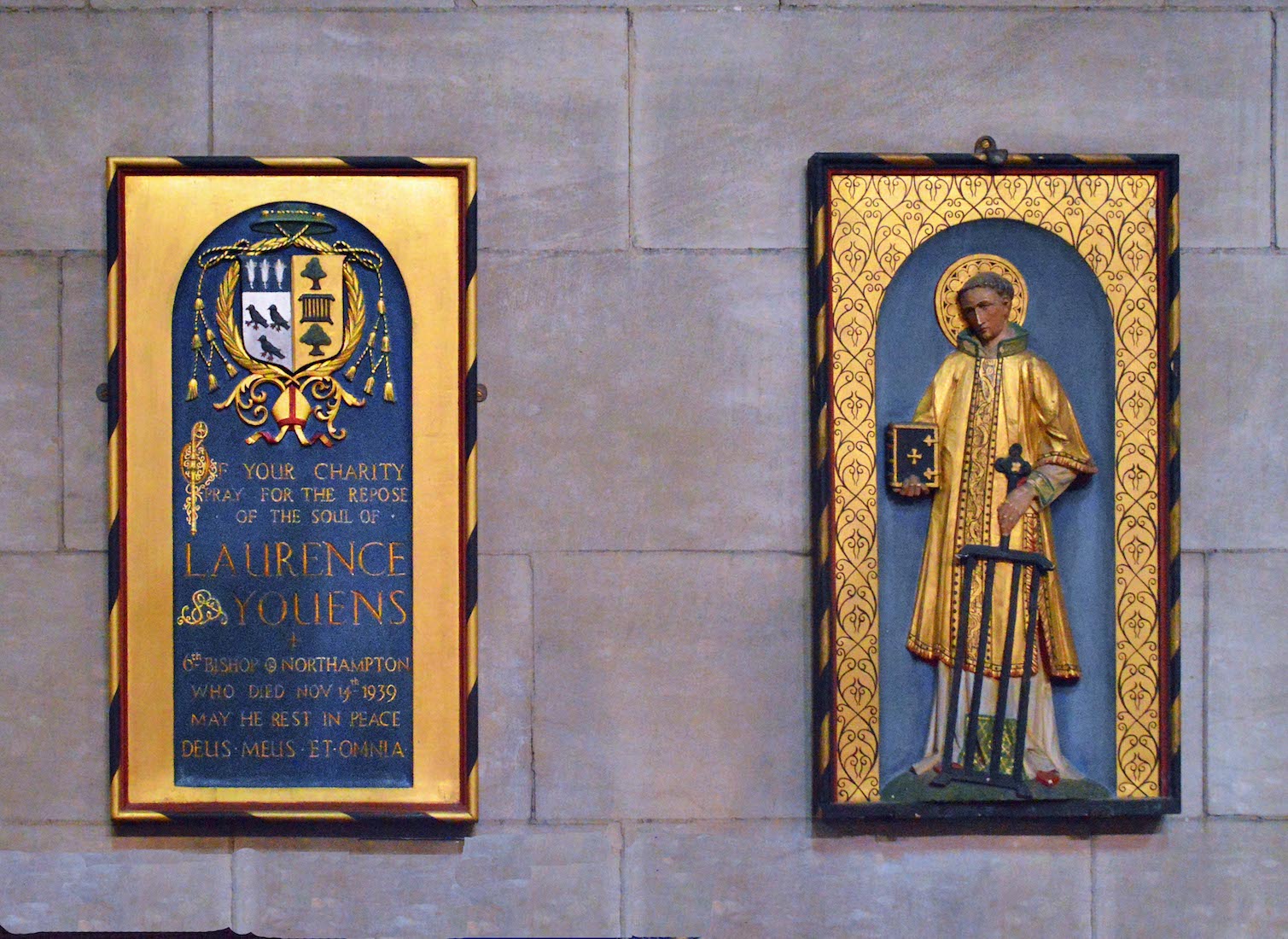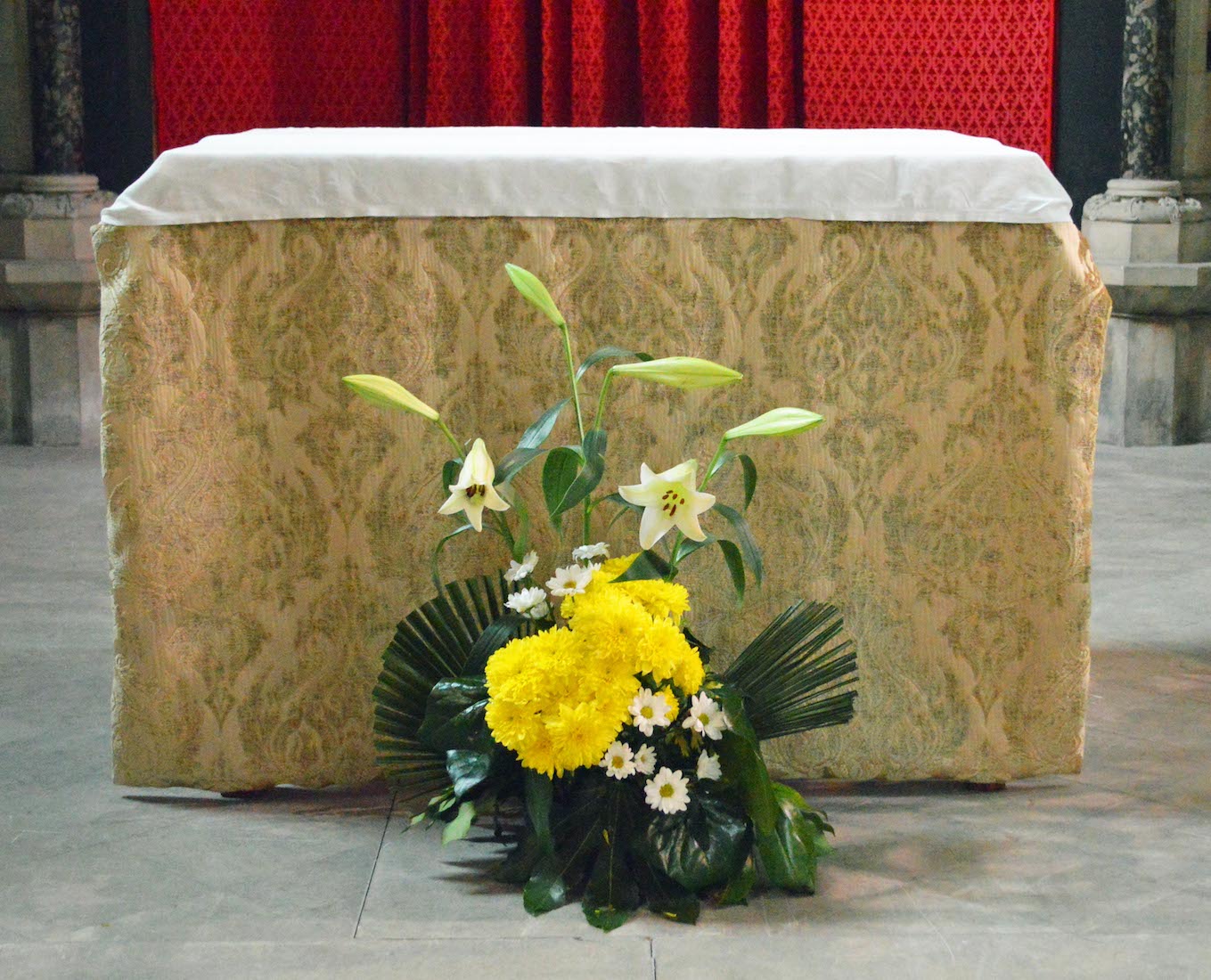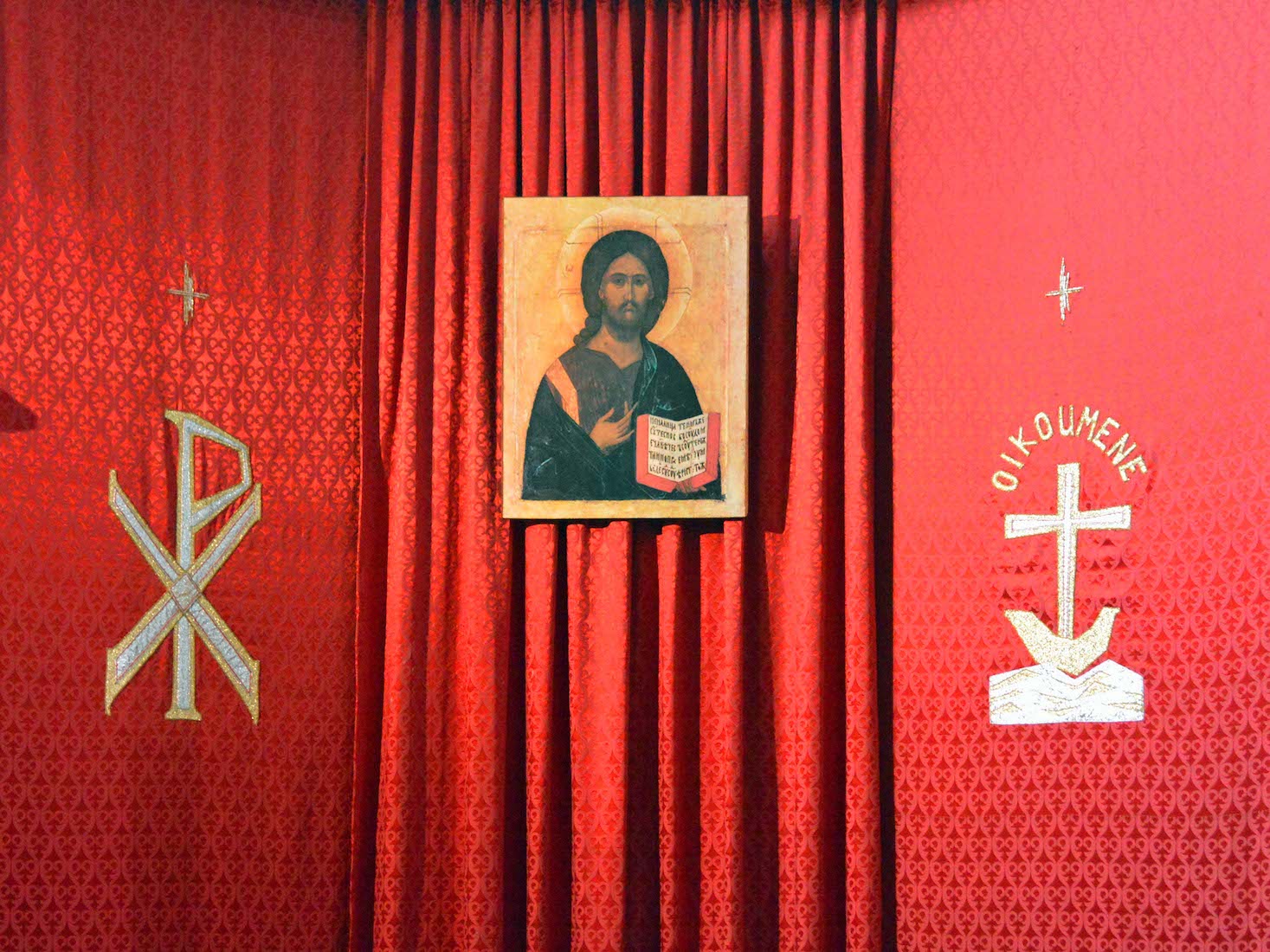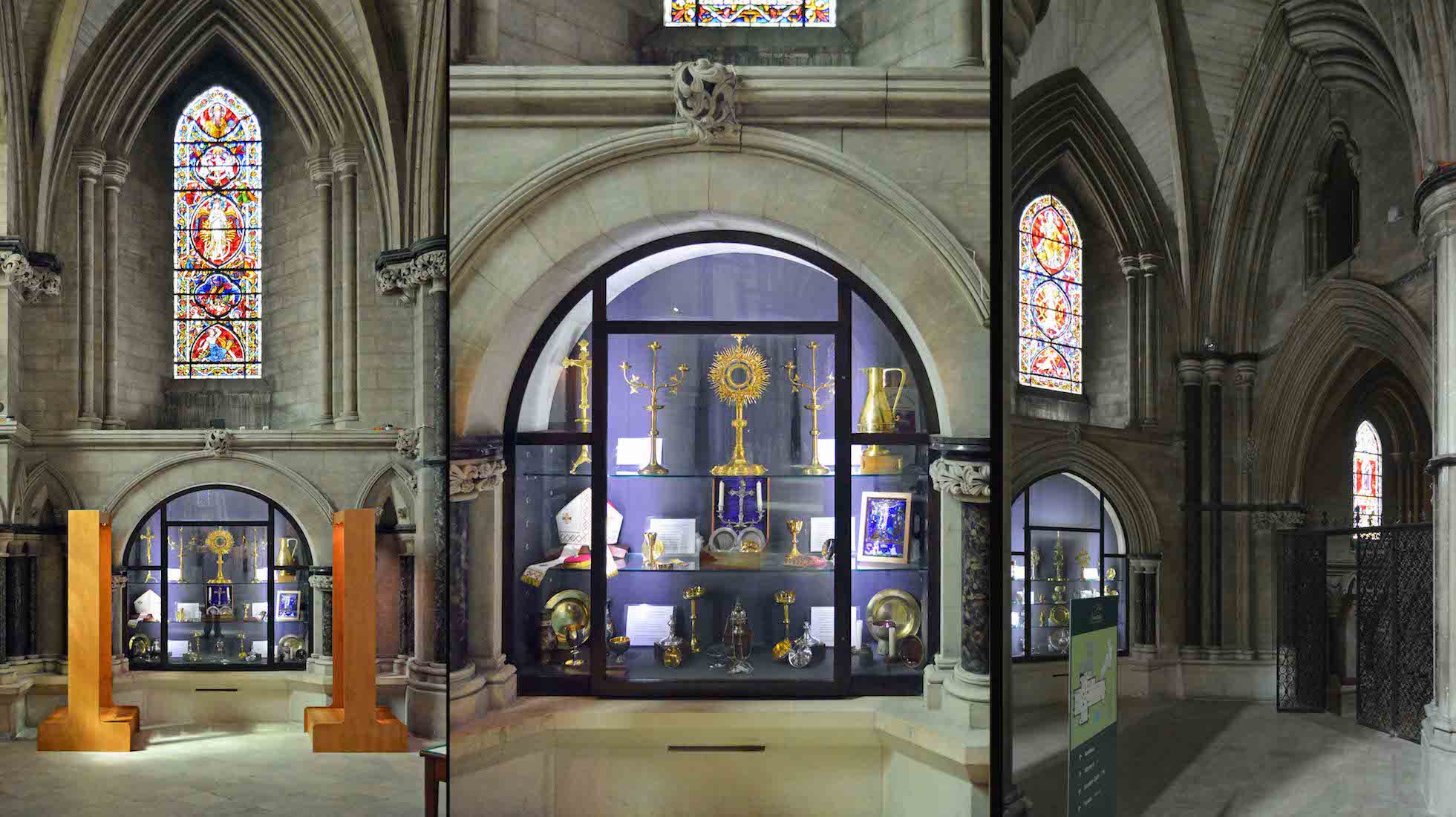
At the West end of the North aisle stands a built in cabinet containing a small Cathedral treasury. Such treasuries tend to accumulate precious items from local parish churches which for various reasons are no longer in use. Items seen here include a crucifix, a monstrance, candlesticks, a ewer, chalices and platens. To our right is the way to the baptistry. PLAN
22. BAPTISTRY WINDOWS
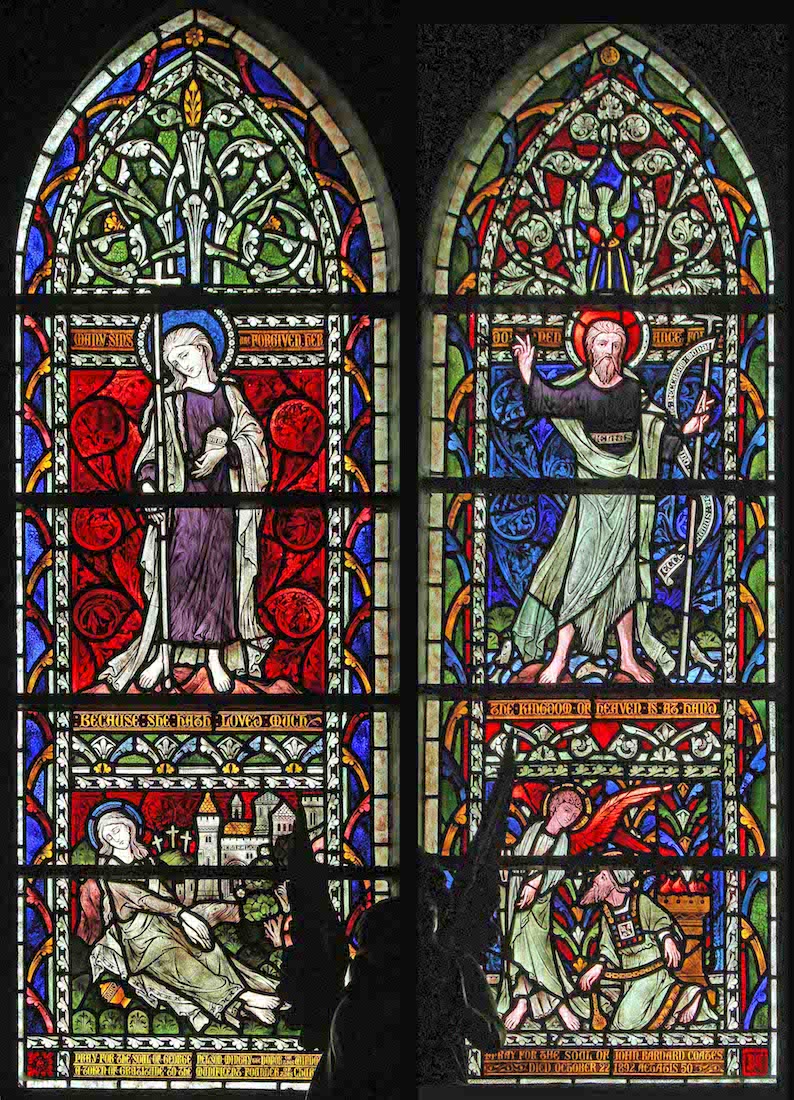
There are two windows in the baptistry. • The West window contains two images of Mary Magdalene. In the upper she is depicted as a single figure whilst in the lower she is visiting Jesus’ tomb. The text is: ‘Many sins are forgiven her because she hath loved much.’ •• In the North window the main image shows John the Baptist over whom the Holy Spirit hovers in the form of a dove. Beneath, the Angel Gabriel appears to John’s father, Zacharias, to tell him that he and his wife Elizabeth will have a child. [Photo credits: Mike Dixon]
23. FONT AND CANOPY
The marble font in the baptistry is of Frosterley marble. Frosterley is a village in County Durham. The marble is a black limestone containing fossil corals of the Carboniferous Period, some 325 million years ago. When cut and polished the result is a beautiful ornate stone, much desired for church decoration, particularly during the Middle Ages. Frosterley Marble has been taken from the Rogerley Quarry for more than 700 years.
24. NORTH AISLE AND WINDOWS
Leaving the baptistry, we walk along the North aisle, past the North doorway, coming to a shrine of the Madonna. The nave windows are almost all Grisaille windows, of which a sample is shown here. Grisaille is a term used for painting in shades of grey, and is also applied to stained glass. A complete set of photos of these windows can be found in Mike Dixon‘s excellent website [see Conclusion].
25. SHRINE AND NORTH AISLE
The origin of this miraculous image of Madonna and Child in Czestochowa, Poland is unknown for absolute certainty, but according to tradition the painting was a portrait of Our Lady done by St. John some time after the Crucifixion of Our Lord, and remained in the Holy Land until discovered by St. Helena of the Cross in the fourth century. This icon is taken from a more elaborate painting. Below is a plaque in memory of Polish men and women who gave their lives during WWII. Looking further down the North aisle, we see another two shrines.
26. ST ANTHONY SHRINE
St Anthony of Padua lived 1195 – 1231. According to legend, a Count Tiso had a castle near Padua, Italy. In the grounds of the castle there was a chapel and a hermitage for the friars. Toward the end of his life, while Anthony was praying, his little cell suddenly filled with light, and Jesus appeared in the form of a tiny child. Passing by, the count saw the light shining and St. Anthony holding and communicating with the infant. The count fell to his knees upon seeing this wondrous sight. So was born the legend of Anthony and the Christ Child.
27. OUR LADY OF PERPETUAL HELP
Our Lady of Perpetual Help (also known as Our Lady of Perpetual Succour) is a Roman Catholic title of the Blessed Virgin Mary as represented in a celebrated 15th-century Byzantine icon. The Greek inscriptions read MP-ΘΥ (Mother of God), OAM (Michael the Archangel), OAΓ (Gabriel the Archangel) and IC-XC (Jesus Christ), respectively.
28. NORTH TRANSEPT
We have now come to the altar platform, and turn towards the North transept. First impressions here are the rows of Gothic columns, the fan vaulting above, and the large stained glass three-lancet window. Apart from the Walsingham Window, all the stained glass windows in this Cathedral were designed by Dunstan J Powell of John Hardman and Co.
29. NORTH TRANSEPT WINDOWS
The original Queen’s Window was completely destroyed in 1942 by a high explosive bomb. After the War it was remade by John Hardman Studios largely to the original design, and reinstated in 1952. The main panels have common themes of holy women and aspects of pilgrimage. •• Central Light: The window is dominated by the central figure of the Virgin Mary holding the boy Jesus, the King of Kings. • Left Light: At top Queen Esther intercedes to save her people from death, at centre are the three wise men – the first pilgrims. Below, beggars and the sick make their own pilgrimage. ••• Right Light: At top the Queen of Sheba with King Solomon. At centre the shepherds from the nativity, whilst below are kings and queens on pilgrimage.
30. WEST WALL OF NORTH TRANSEPT
This wall of the transept is fairly plain. We notice a diamond shaped hatchment high in the arch: we shall see more of these later in our tour. The doors at right exit to the outside. And at the extreme right we notice a model of the Cathedral.
31. CATHEDRAL MODEL
Many cathedrals have a model on display – often very detailed in nature. Such models are useful for giving an overview of the cathedral, and especially of those parts which are not easy to see. This model was obviously made before the new narthex was added.
32. WALSINGHAM CHAPEL AND PIETÀ ALTAR
Unusually, the East wall of the North transept opens up completely to the Walsingham Chapel and the Pietà altar. We now investigate these. The Walsingham Chapel windows were made and designed by Clayton & Bell to tell the history of the shrine at Walsingham from the date of its foundation in 1061 to its destruction at the Reformation. During WWII the windows were severely damaged. They were subsequently remade and the subject matter updated.
33. WALSINGHAM CHAPEL WINDOWS
In this chapel there is a North window (left) and three East windows. The three scenes in the North window show Lady de Favarches in prayer, Sir Geoffrey de Favarches founding the Abbey, and the Duke and Duchess of Norfolk on pilgrimage to the shrine. In the central East window, Our Lady of Walsingham sits on her throne holding the Infant Jesus. These windows are extremely detailed – too much so to be described in the limited space available here. For further information, see Mike Dixon’s site, http://norwichcathedrals-stainedglass.org/RC_cathedral/home.html . [Left photo credit: Mike Dixon]
34. WALSINGHAM CHAPEL ALTAR
We see here the Walsingham Chapel altar and reredos. Walsingham is a village in the English county of Norfolk. The village is famed for its religious shrines in honour of the Virgin Mary and as a major pilgrimage centre. Walsingham became a major centre of pilgrimage after 1061, when according to legend, a Saxon noblewoman, Richeldis de Faverches, had a vision of the Virgin Mary in which she was instructed to build a replica of the house of the Holy Family in Nazareth in honour of the Annunciation.
35. PIETÀ AND WINDOW
The original sculpture Pietà (1498–1499) is a work of Renaissance sculpture by Michelangelo Buonarroti, housed in St. Peter's Basilica, Vatican City. It depicts the body of Jesus on the lap of his mother Mary after the Crucifixion. Above, the main figures in the ‘Window of the Holy See’ are Saint Peter (blue background) and Pope Pius X, both holding symbolic keys to heaven. Above them, Christ instructs Peter to: ‘Feed my Lambs’, whilst below, St Gregory sends St Augustine out to: ‘Go teach all nations.’
37. TWO FRAMED IMAGES
Out of sight in our last view, but on the left wall, are these two framed images. At left is a memorial to Laurence Youens who was Bishop of Northampton, and died in 1939. At right is a picture of St Laurence. Laurence or Lawrence of Rome (c. 225–258) was one of the seven deacons of the city of Rome under Pope Sixtus II who were martyred during the persecution by Emperor Valerian in 258. He is often pictured with a gridiron which illustrates his martyrdom.
38. BAS-RELIEF AND ICON
Also on the North wall of the Unity Chapel is this colourful bas-relief of the Annunciation, with the angel appearing to Mary. The icon of Christ stands to the left of the Chapel altar.
39. UNITY CHAPEL ALTAR
The chapel altar is a simple covered table without decoration, apart from the striking floral display which matches the colour of the flowers on the nave columns.
40. UNITY CHAPEL SCREEN
The reredos behind the chapel altar carries two symbols and a central icon. At left is a Chi-Rho symbol standing for Christ. At right there is a cross and dove and the Greek word Oikoumene, meaning ‘the inhabited world’, but ‘ecumenical’ in Christian circles, speaking of unity. At centre is an icon of Christ, (presumably) holding an open Bible.



